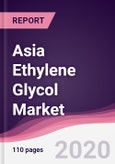What is ethylene glycol?
Ethylene glycol is an odorless, colorless, viscous alcohol-based liquid. It is widely used as a raw material in the manufacture of polyester fibers and for antifreeze formulations. The three ethylene glycols are monoethylene glycol, diethylene glycol and triethylene glycol. These glycols have similar chemical properties but different physical properties and hence vary in applications. Properties such as high boiling points, hygroscopicity, non-corrosiveness, plasticizing, freeze point depression and lubrication has broadened its use for various applications.
What are the applications of Ethylene Glycol?
Ethylene glycol is commercially used as an antifreeze and coolant. For instance, ethylene glycol avoids overheating of car’s engine during summer and freezing during winter. Ethylene glycol is used as industrial coolants for gas compressors, heating, ventilating, and air-conditioning systems, and ice skating rinks. It is also used in polyethylene terephthalate (PET) resins which is used to make plastic bottles for soft drinks and packaging films. It is used in manufacturing of polyester fibers for clothes, carpet and pillows. It is also used in the manufacture of fiber glass for bathtubs, jet skis and bowling balls. These products are preferred as they are energy saving, cost efficient and recyclable.
Market Research and Market Trends of Asia’s Ethylene Glycol Market:
- Due to the low availability of oil and gas in China, the ethylene glycol market in China is slowly shifting its focus on the manufacturing of ethylene glycol from coal than petroleum route. This technology uses coal as a feedstock instead of petroleum. China is anticipated to commercialize its coal based ethylene glycol manufacturing process in next couple of years.
- Human pluripotent cells are essential in various clinical researches. Hence, it is necessary to preserve these cells so that the cells do not deteriorate. The various other slow freezing method resulted in cell dissociation with poor post thaw survival. Recently, a new combination of cryopreservant which includes 6% HES, 5% DMSO and 5% ethylene glycol has proved to achieve achieved post-thaw recoveries up to 80% and hence is extensively used.
- Extensive research is carried out for enzymatic recycling process of PET. Many companies have demonstrated the successful depolymerization of PET based commercial products such as bottles, packaging films into TPA and monoethylene glycol. This innovation gives a wide scope to recycle all the PET products which was otherwise sent to landfill or incineration causing environmental pollution.
- Bio-PET is produced from plant-based MEG rather than petroleum-based MEG. This plant based MEG is produced from agricultural wastes such as includes molasses, hay and bagasse. Bio-PET is widely used I making water and soda bottles as they are environmental friendly. Bio – PET have similar properties as that of regular PET and can be recycled. These recycled products can be used in bottles or as fibers in polyester industries. Bio PET bottles have been trusted by leading drink manufacturers such as Coco Cola (Japan) and has earned various accreditation from Japan food and Drug association.
Who are the Major Players in Asia’s Ethylene Glycol market?
The companies referred in the market research report includes China Petrochemical Corporation, NAN YA PLASTICS Corporation, Reliance Industries Limited, Oriental Union Chemical Corporation, Royal Dutch Shell plc and several others.
What is our report scope?
The report incorporates in-depth assessment of the competitive landscape, product market sizing, product benchmarking, market trends, product developments, financial analysis, strategic analysis and so on to gauge the impact forces and potential opportunities of the market. Apart from this the report also includes a study of major developments in the market such as product launches, agreements, acquisitions, collaborations, mergers and so on to comprehend the prevailing market dynamics at present and its impact during the forecast period 2020-2025.
Key Takeaways from this Report
- Evaluate market potential through analyzing growth rates (CAGR %), Volume (Units) and Value ($M) data given at country level – for product types, end use applications and by different industry verticals.
- Understand the different dynamics influencing the market – key driving factors, challenges and hidden opportunities.
- Get in-depth insights on your competitor performance – market shares, strategies, financial benchmarking, product benchmarking, SWOT and more.
- Analyze the sales and distribution channels across key geographies to improve top-line revenues.
- Understand the industry supply chain with a deep-dive on the value augmentation at each step, in order to optimize value and bring efficiencies in your processes.
- Get a quick outlook on the market entropy – M&A’s, deals, partnerships, product launches of all key players for the past 4 years.
- Evaluate the supply-demand gaps, import-export statistics and regulatory landscape for more than top 20 countries globally for the market.
Table of Contents
Methodology

LOADING...








